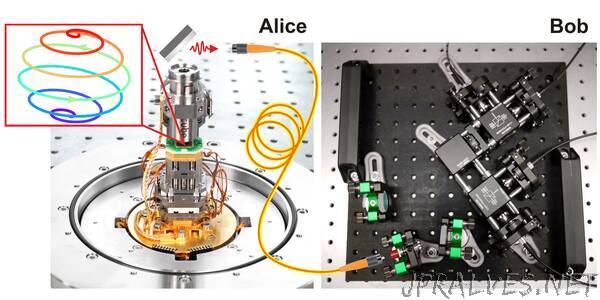
“Team of researchers from Münster, Bayreuth and Berlin propose a new way of generating single photons
After the “first quantum revolution” – the development of devices such as lasers and the atomic clock – the “second quantum revolution” is currently in full swing. Experts from all over the world are developing fundamentally new technologies based on quantum physics. One key application is quantum communication, where information is written and sent in light. For many applications making use of quantum effects, the light has to be in a certain state – namely a single photon state. But what is the best way of generating such single photon states? In the PRX Quantum journal, researchers from Münster, Bayreuth and Berlin have now proposed an entirely new way of preparing quantum systems in order to develop components for quantum technology.
In the experts’ view it is highly promising to use quantum systems for generating single photon states. One well-known example of such a quantum system is a quantum dot. This is a semiconductor structure, just a few nanometres in size. Quantum dots can be controlled using laser pulses. Although quantum dots have properties similar to those of atoms, they are embedded in a crystal matrix, which is often more practical for applications. “Quantum dots are excellent for generating single photons, and that is something we are already doing in our labs almost every day,” says Dr. Tobias Heindel, who runs an experimental lab for quantum communication at the Technical University of Berlin. “But there is still much room for improvement, especially in transferring this technology from the lab to real applications,” he adds.
One difficulty that has to be overcome is to separate the generated single photons from the exciting laser pulse. In their work, the researchers propose an entirely new method of solving this problem. “The excitation exploits a swing-up process in the quantum system,” explains Münster University’s Thomas Bracht, the lead author of the study. “For this, we use one or more laser pulses which have frequencies which differ greatly from those in the system. This makes spectral filtering very easy.”
Scientists define the “swing-up process” as a particular behaviour of the particles excited by the laser light in the quantum system – the electrons or, to be more precise, electron-hole pairs (excitons). Here, laser light from two lasers is used which emit light pulses almost simultaneously. As a result of the interaction of the pulses with one another, a rapid modulation occurs, and in each modulation cycle, the particle is always excited a little, but then dips towards the ground state again. In this process, however, it does not fall back to its previous level, but is excited more strongly with each swing up until it reaches the maximum state. The advantage of this method is that the laser light does not have the same frequency as the light emitted by the excited particles. This means that photons generated from the quantum dot can be clearly assigned.
The team simulated this process in the quantum system, thus providing guidelines for experimental implementation. “We also explain the physics of the swing-up process, which helps us to gain a better understanding of the dynamics in the quantum system,” says associate professor Dr. Doris Reiter, who led the study.
In order to be able to use the photons in quantum communication, they have to possess certain properties. In addition, any preparation of the quantum system should not be negatively influenced by environmental processes or disruptive influences. In quantum dots, especially the interaction with the surrounding semiconductor material is often a big problem for such preparation schemes. “Our numerical simulations show that the properties of the photons generated after the swing-up process are comparable with the results of established methods for generating single photons, which are less practical,” adds Prof. Martin Axt, who heads the team of researchers from Bayreuth.
The study constitutes theoretical work. As a result of the collaboration between theoretical and experimental groups, however, the proposal is very close to realistic experimental laboratory conditions, and the authors are confident that an experimental implementation of the scheme will soon be possible. With their results, the researchers are taking a further step towards developing the quantum technologies of tomorrow.
Funding
The project team from Münster received financial support from the German Research Association (DFG) as part of project 428026575. Tobias Heindel receives funding from the German Ministry of Education and Research (BMBF) through the “QuSecure” project (Grant No. 13N14876) as part of Photonics Research Germany. Alexei Vagov received financial support from the Russian Science Foundation through project No. 18-12-00429.
Original publication:
Thomas K. Bracht, Michael Cosacchi, Tim Seidelmann, Moritz Cygorek, Alexei Vagov, V. Martin Axt, Tobias Heindel, and Doris E. Reiter (2021): Swing-Up of Quantum Emitter Population Using Detuned Pulses. PRX Quantum 2, 040354; DOI: 10.1103/PRXQuantum.2.040354”
